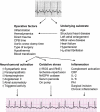Pharmacological strategies for prevention of postoperative atrial fibrillation
- PMID: 25697411
- PMCID: PMC5561732
- DOI: 10.1586/17512433.2015.1018182
Pharmacological strategies for prevention of postoperative atrial fibrillation
Abstract
Atrial fibrillation (AF) complicating cardiac surgery continues to be a major problem that increases the postoperative risk of stroke, myocardial infarction, heart failure and costs and can affect long-term survival. The incidence of AF after surgery has not significantly changed over the last two decades, despite improvement in medical and surgical techniques. The mechanism and pathophysiology underlying postoperative AF (PoAF) is incompletely understood and results from a combination of acute and chronic factors, superimposed on an underlying abnormal atrial substrate with increased interstitial fibrosis. Several anti-arrhythmic and non-anti-arrhythmic medications have been used for the prevention of PoAF, but the effectiveness of these strategies has been limited due to a poor understanding of the basis for the increased susceptibility of the atria to AF in the postoperative setting. In this review, we summarize the pathophysiology underlying the development of PoAF and evidence behind pharmacological approaches used for its prevention in the postoperative setting.
Keywords: amiodarone; anti-arrhythmic agents; antioxidants; cardiac surgery; postoperative atrial fibrillation; prevention; statins; β-blockers.
Figures


Similar articles
-
Atrial fibrillation after cardiac surgery.Ann Card Anaesth. 2010 Sep-Dec;13(3):196-205. doi: 10.4103/0971-9784.69047. Ann Card Anaesth. 2010. PMID: 20826960 Review.
-
The changing face of postoperative atrial fibrillation prevention: a review of current medical therapy.Cardiol Rev. 2007 Sep-Oct;15(5):231-41. doi: 10.1097/CRD.0b013e31813e62bb. Cardiol Rev. 2007. PMID: 17700382 Review.
-
Postoperative atrial fibrillation: mechanisms, manifestations and management.Nat Rev Cardiol. 2019 Jul;16(7):417-436. doi: 10.1038/s41569-019-0166-5. Nat Rev Cardiol. 2019. PMID: 30792496 Review.
-
Antioxidant interventions as novel preventive strategies for postoperative atrial fibrillation.Int J Cardiol. 2010 Nov 5;145(1):140-2. doi: 10.1016/j.ijcard.2009.06.054. Epub 2009 Jul 17. Int J Cardiol. 2010. PMID: 19616323 Review.
-
Antiarrhythmic therapy on prevention of postoperative atrial fibrillation in patients after heart surgery.Curr Med Chem Cardiovasc Hematol Agents. 2004 Jan;2(1):29-34. doi: 10.2174/1568016043477387. Curr Med Chem Cardiovasc Hematol Agents. 2004. PMID: 15320804 Review.
Cited by
-
Atorvastatin and the influence on postoperative atrial fibrillation after surgical aortic valve replacement (STARC) in adults at Odense University Hospital, Denmark: study protocol for a randomised controlled trial.BMJ Open. 2023 May 10;13(5):e069595. doi: 10.1136/bmjopen-2022-069595. BMJ Open. 2023. PMID: 37164465 Free PMC article.
-
Artificial intelligence to predict biomarkers for new-onset atrial fibrillation after coronary artery bypass grafting.Turk Gogus Kalp Damar Cerrahisi Derg. 2025 Apr 30;33(2):144-153. doi: 10.5606/tgkdc.dergisi.2025.27304. eCollection 2025 Apr. Turk Gogus Kalp Damar Cerrahisi Derg. 2025. PMID: 40575054 Free PMC article.
-
Circulating Biomarkers Predictive of Postoperative Atrial Fibrillation.Cardiol Rev. 2016 Mar-Apr;24(2):76-87. doi: 10.1097/CRD.0000000000000059. Cardiol Rev. 2016. PMID: 25699982 Free PMC article. Review.
-
A novel predictive model for new-onset atrial fibrillation in patients after isolated cardiac valve surgery.Front Cardiovasc Med. 2022 Sep 29;9:949259. doi: 10.3389/fcvm.2022.949259. eCollection 2022. Front Cardiovasc Med. 2022. PMID: 36247462 Free PMC article.
-
Commentary: We don't need no postop AF… All in all it's just another (β)-block in the wall.JTCVS Open. 2020 Aug 8;3:88-90. doi: 10.1016/j.xjon.2020.08.003. eCollection 2020 Sep. JTCVS Open. 2020. PMID: 36003868 Free PMC article. No abstract available.
References
-
- Mathew JP, Fontes ML, Tudor IC, et al. A multicenter risk index for atrial fibrillation after cardiac surgery. JAMA. 2004;291(14):1720–1729. - PubMed
-
- El-Chami MF, Kilgo P, Thourani V, et al. New-onset atrial fibrillation predicts long-term mortality after coronary artery bypass graft. J Am Coll Cardiol. 2010;55(13):1370–1376. - PubMed
-
- Mariscalco G, Engstrom KG. Postoperative atrial fibrillation is associated with late mortality after coronary surgery, but not after valvular surgery. Ann Thorac Surg. 2009;88(6):1871–1876. - PubMed
-
- Ahlsson A, Fengsrud E, Bodin L, Englund A. Postoperative atrial fibrillation in patients undergoing aortocoronary bypass surgery carries an eightfold risk of future atrial fibrillation and a doubled cardiovascular mortality. Eur J Cardiothorac Surg. 2010;37(6):1353–1359. - PubMed
Publication types
MeSH terms
Substances
Grants and funding
LinkOut - more resources
Full Text Sources
Other Literature Sources
Medical
